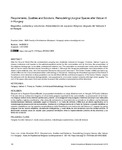Requirements, Qualities and Solutions. Remodelling Liturgical Spaces after Vatican II in Hungary

Ver/
Use este enlace para citar
http://hdl.handle.net/2183/25381
A non ser que se indique outra cousa, a licenza do ítem descríbese como Atribución-NoComercial 4.0 España
Coleccións
Metadatos
Mostrar o rexistro completo do ítemTítulo
Requirements, Qualities and Solutions. Remodelling Liturgical Spaces after Vatican II in HungaryTítulo(s) alternativo(s)
Requisitos, calidades y soluciones: remodelación de espacios litúrgicos después del Vaticano II en HungríaAutor(es)
Data
2020Cita bibliográfica
Urbán, Erzsébet. 2019. «Requisitos, Calidades Y Soluciones». Actas De Arquitectura Religiosa Contemporánea 6 (diciembre), 130-43. https://doi.org/10.17979/aarc.2019.6.0.6233
Resumo
[Abstract] After the Second World War the ecclesiastical property was drastically reduced in Hungary. However, Vatican II gave an
intense motivation and impulse to the spiritual-psychical revival for the communities and by this time, the preservation of
the religious heritage got some statal, professional attention too. The restoration or reconstruction works were often linked
with the acute interior transformations according to Vatican II. Although the Hungarian publication and interpretation of the
reforms were relatively slow, still a few essential informative discussions were born. The Venice Charter (1964) also had a significant
effect on the monument preservation methodology in this period. Analysing the theoretical approach of the Vatican II
Constitution and Instruction a close parallelism can be identified with the architectural aspects of the Venice Charter: respect
the old parts with the obviously distinguishable, new supplements, and create modern artworks with high artistic quality. The
end of the paper cites some brief case studies to present the practical implementation of the directives. [Resumen] Después de la Segunda Guerra Mundial, la propiedad eclesiástica se redujo drásticamente en Hungría. El Concilio Vaticano
II dio una intensa motivación e impulso al avivamiento psíquico-espiritual de las comunidades. La preservación de la herencia
religiosa recibió cierta atención profesional y estatal. La investigación arqueológica e histórica comenzó a ser exhaustiva
en las capillas e iglesias medievales, y las obras de restauración o reconstrucción a menudo se vincularon con las intensas
transformaciones interiores realizadas según el Vaticano II. La Carta de Venecia (1964) tuvo un efecto significativo en la
metodología de preservación de monumentos. Analizando el enfoque teórico de la Carta de Venecia, se puede identificar un
estrecho paralelismo con los aspectos arquitectónicos de la Constitución y la Instrucción del Vaticano II: respetar las partes
antiguas con los nuevos añadidos, obviamente distinguibles, y crear obras de arte modernas con alta calidad artística. El
documento examina casos de estudio para presentar similitudes entre la implementación práctica de las directivas y las
líneas de actuación.
Palabras chave
Hungary
Vatican II
Theory vs. Practice
Architectural methodology
Venice Charter
Hungría
Concilio Vaticano II
Teoría versus práctica
Metodología arquitectónica
Carta de Venecia
Vatican II
Theory vs. Practice
Architectural methodology
Venice Charter
Hungría
Concilio Vaticano II
Teoría versus práctica
Metodología arquitectónica
Carta de Venecia
Versión do editor
Dereitos
Atribución-NoComercial 4.0 España
ISSN
2340-5503






